Indigenous People's Park is located at the east side of National Palace Museum and the west side of Private Wesley Girls High School on Section 2, Chihshan Road in Shilin District. Facing Shunyi Taiwan Aborigine Museum, the total area of this park is 23,794 sq. meters. It was the first public park in Taipei designed with aborigine culture as its primary theme.
Though the aborigines constitute less than 2% as of Taiwanese total population, the rich diversity of aborigine arts and cultures cannot be described simply and quickly. Therefore the park is divided into 5 main areas, including plaza area, main sidewalk area, natural stream area, landscape-pond area and recreation area. See as follows:
I. Plaza area: The Plaza area represents the open-minded character of the aboriginal people. As for its practical uses, said area satisfies the demands that serves not only for tourists to gather or congregate but also provides aboriginal artists with a good space for cultural activities and art exhibition.
(I) Entrance totems: There are 13 cubic rock columns with embossments in the spacious plaza which serve as the park’s entrance sign. There's crescent moon-shaped pond with highlights. The sun and moon modeling symbolizes the origin of living energy. The rock columns demonstrate the residential stones of the 13 aborigine tribes. Taiwanese aboriginal tribes include: the Taiya, Saisiyat, Tsou, Thao, Bunun, Rukai, Paiwan, Baenan, Yami, Saitek, Kavalan, Amis and Pingpu. The rock columns also symbolize the tribal borders, their status and the esteem with which tribal customs are revered. The same height of rock columns symbolizes the spirit of community, equality and harmony among the 13 tribes. A male figure was engraved on the northern side of the column while a male chief was carved in a dual-system community. On the side facing Chihshan Road, a snake totem is shown as its representative.
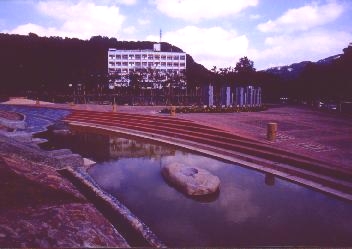
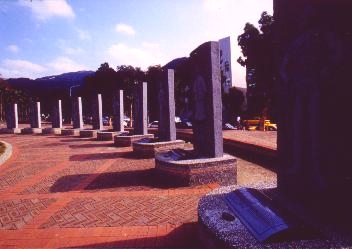 |
(II) Entrance Plaza: This plaza is divided into east and west sections to provide a small space for activities and exhibitions of aboriginal works of art.
(III) Central Plaza: The central plaza accommodates occasional rituals and larger cultural activities of the aborigines. The round shaped plaza is in the middle and surrounded with a gradually sloping meadow. Betel palm trees were planted on both sides of the plaza and its surrounding meadow. Natural rocks were laid at both sides of the plaza. Natural rocks are laid all over the slope instead of artificial seats in order to express the spirit of aborigines' respect for and conservation of natural resources.
(IV) Water Playing Area: The west side of the entrance plaza is the terminal of the stream winding from north to south. A water slide is designed into one slope to provide a fun distraction for children, and a snake totem stands as a symbol of aboriginal culture.
(V) Culture Corridor: The semi-underground aborigine-styled overlaid stone foundation is used as the molding for the Culture Corridor, which extends from the north end of the central plaza to the northeastern corner. The internal seats are covered with overlaid stones or flagstones to display the traditional and modern plane art products of aborigines.
II. Main Sidewalk Area: The main sidewalk crossing the south and north parts of the park provides a quiet area for people to take a walk. The planting of azaleas and the variations of gradient block the varied landscape and produce an atmosphere of peaceful serenity. The red azaleas, which symbolize fire, the stones and the flowing water of the man-made streams represent the energy of life and the elements of the universe.
III. Natural Stream: At the highest position of the northern lies a reservoir, which retains rainfall and provides water for the natural waterfall. All the water flows into the natural stream through the landscaped pond. The flowing water symbolizes the vigor and energy of the universe.
IV. Landscaped Pond: This pond was rebuilt from an existing natural pond with ecological gardening techniques. A pavilion constructed in the Shao tribal style stands beside the pond as a demonstration of a traditional residence of this tribe.
V. Recreation Area: Using the natural slope, this area is designed to be a wild and natural space. Additionally, the spirits of the Yamei tribe's flagstone houses are evoked to build a sense of cultural identity. There are also a resting pavilion and a stair maze for children to play in.
Location of the Park:No. 221, Sec. 2, Zhishan Road, Shihlin District.
Transportation:public utility bus(pub)No. 255 or mini city bus No. 8.
Administering Dept.:Yangmingshan Park Administration service line:2861-65333
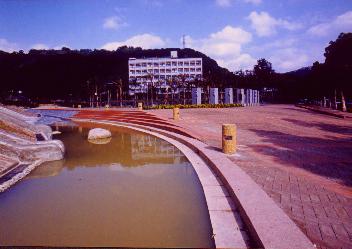
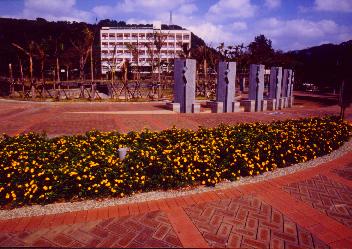
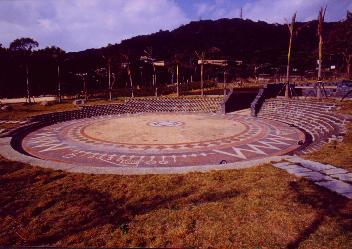



![Taiwan.gov.tw [ open a new window]](/images/egov.png)
